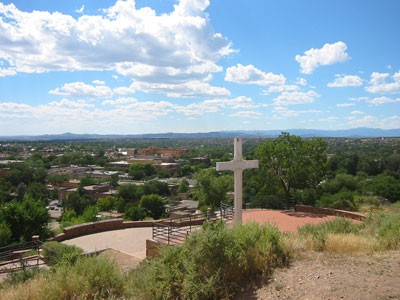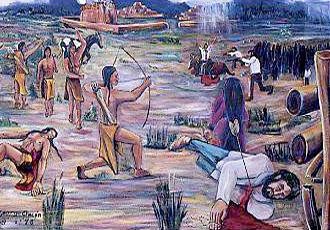Cross of the Martyrs
Introduction
Text-to-speech Audio
Images

The Cross of the Martyrs was dedicated on September 15, 1920

Artistic depiction of the Pueblo Revolt

Backstory and Context
Text-to-speech Audio
The Pueblo Revolt of 1680, also known as Popé's Rebellion, occurred due to a long history of contention between the Spanish colonizers and native peoples. From 1540 to 1600, seven waves of soldiers, missionaries, and settlers travelled to present-day New Mexico, conquering and settling the area. This period of time, called the Entradas, is filled with violent conflict between the Pueblos and the Spanish.
A significant one of these encounters, known as the Acoma Massacre, established a culture of fear in the native population. This massacre occurred in 1598 and was led by Juan de Oñate. Oñate, full name Don Juan de Oñate y Salazar, was a Spanish conquistador, explorer, and colonial governor in Santa Fe. He led 129 soldiers and 10 Franciscan Catholic priests, along with women, children, servants, slaves, and livestock into the Rio Grande Valley, where approximately 40,000 Pueblos lived at the time. Here, Oñate stopped a revolt at Acoma Pueblo by killing and enslaving hundreds of native peoples. He also had the right foot of 24 men cut off. Although there were Spanish colonial laws in place during the 1500s preventing this type of inhumane treatment of native peoples, they were very difficult to enforce this far north in the Spanish territories.
A drought swept through the region about a decade before the Pueblo Revolt of 1680, which created starving conditions for the Spanish as well as the native peoples, increasing tensions between the groups. Then, in 1675, Governor Juan Francisco Treviño arrested 47 Pueblo medicine men on the grounds that they were practicing sorcery. Three of these men were hanged. At the time, a large number of Spanish troops were away fighting the Apache, which meant that Governor Treviño had to agree to the Pueblo’s demand that the remaining medicine men be released. One of the released prisoners was Popé, the leader of the Pueblo revolt.
